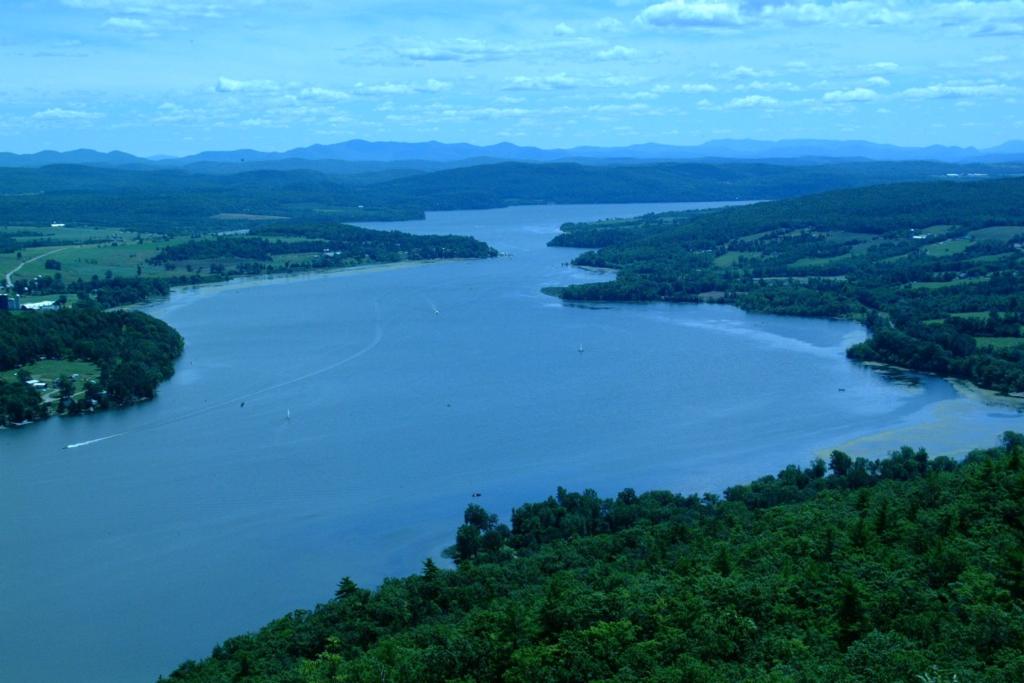Bass fishing’s civil war

Is American bass fishing better in the North than it is in the South? What about the West?
Part one (of two parts)
When the Wal-Mart FLW Tour wrapped up its 2002 regular season in Plattsburgh, N.Y., pro anglers across the board raved about the prolific Lake Champlain bass fishery.
“With its abundant smallmouth and largemouth populations and its scenic beauty, it’s probably No. 1 in the country,” hailed Missouri pro bass legend Rick Clunn.
“Without a doubt, this is the best lake in the United States,” North Carolina pro David Dudley said. “It has largemouth. It has smallmouth. It has it all.”
Connecticut pro Jimmi Leuthner, who calls Lake Champlain his home waters, drew a line in the sand: “I’ve been fishing down south for about six months now and it’s been some tough fishing. It’s great to be home because this is the best fishing in the country.”
Lake Champlain is certainly an exceptional bass fishery; it holds several current FLW Tour overall catch weight records. But we’ve heard this kind of rhetoric before when the tour has ventured above the Mason-Dixon Line. When the FLW Tour made stops at Michigan’s Lake St. Clair in 1999 and 2001, anglers’ praise for that fishery – another smallmouth honey hole – also approached hyperbole.
“The fishing here is just insane,” Florida co-angler James Shockey said of Lake St. Clair. “It’s the only place I know of where you can go out, park your boat in 4 feet of water and catch fish anywhere on the lake.”
“The first thing I asked when the new schedule came out was, `When do we get to go to Lake St. Clair?'” Georgia pro Mickey Bruce said in 2001. “I love coming here. I tell you, it’ll make your thumb raw out there.”
The FLW Tour spends the majority of its time below the Mason-Dixon Line. Of the 48 tournaments held since the tour began in 1996, 42 of them have been held on what are generally classified as “southern” waters. Yet the top two tournaments in terms of catching fish, by a wide margin, were both held on “northern” lakes. Before Champlain set FLW total weight and numbers records, St. Clair held them. Consequently, both St. Clair and Champlain receive high praise from some of the nation’s best anglers – many of them born and raised on big southern reservoirs. These pros use words like “the best,” “No. 1” and “favorite” in describing these northern fisheries.
But what does that mean? Are Champlain and St. Clair indicative of the overall so-called “northern bass-fishing experience”? Is the bass fishing in the North better than it is in the South – where the sport and its history began? Is that even a fair question to ask?
The case for the North
“Yeah, (bass) fishing is better in the North than in the South,” said Kellogg’s pro Clark Wendlandt, who hails from Texas.
“If you’re speaking in generalities, I think in the North you do catch more fish per hour than in southern waters,” Minnesota pro Jim Moynagh said.
The tournament numbers seem to support the contention. After seven years of competition, the average overall weight of the fish caught by the Pro Division at a regular-season FLW tournament is 2,232 pounds, 5 ounces. At Lake Champlain in 2002, the pros set an FLW Tour record with a cumulative weight of 4,916-2. The 1999 Lake St. Clair tourney ranks second with a total of 4,310-0.
 In the five regular-season FLW tournaments that have been held in the North since 1996, pros averaged 3,200 pounds, 13 ounces per event. In the 37 southern events, they averaged 2,101-6 per tourney. (The six championship tournaments held since 1996 – six southern and two northern – were not factored into the overall weight averages since those events had significantly smaller tournament fields and one was cancelled.)
In the five regular-season FLW tournaments that have been held in the North since 1996, pros averaged 3,200 pounds, 13 ounces per event. In the 37 southern events, they averaged 2,101-6 per tourney. (The six championship tournaments held since 1996 – six southern and two northern – were not factored into the overall weight averages since those events had significantly smaller tournament fields and one was cancelled.)
On the EverStart Series – which has more tournaments per season and a subsequently broader geographical reach – the introduction of the Northern Division in 2001 pushed tournament catch weights ever higher for that circuit. In 2002, it was Lake Champlain, not surprisingly, that dominated the EverStart’s total weight category with 3,636 pounds, 13 ounces caught by the pros. That was closely followed up by the Thousand Islands, Lake Ontario, tournament with 3,503-14 and the Detroit River tournament (with access to Lake St. Clair and western Lake Erie) with 3,496-3.
In 2002, the Northern Division pros accumulated a combined 11,937 pounds, 2 ounces in four tournaments fished, while the Eastern Division pros accumulated 10,372-9 and the Central Division pros 7,672-15. (It should be noted that the Eastern and Central divisions of the EverStart Series are geographically located in what is generally considered the South. The Eastern Division is comprised of far southeastern states like Florida, the Carolinas and Alabama and the Central Division focuses on south-central states from Kentucky to Texas.)
The Northern pro weight totals averaged 2,984 pounds, 5 ounces per tournament in 2002. The Eastern totals averaged 2,593-2 while the Central averaged 1,918-4.
“Yeah, I’d like to see the FLW hold all of its tournaments north of Missouri,” said Moynagh, whose FLW resume perhaps belies his penchant for northern tournaments. Every single one of his top-10 finishes on the FLW Tour, including a win at Minnesota’s Lake Minnetonka, came in the North. “The hard thing to get used to every year, after fishing in places like Minnesota and Canada in June, July and August, is in the fall when we start going south. That’s a hard adjustment for me to make.”
Lake size and fishing pressure
Fishing pressure is probably the single biggest reason anglers might find bassing more appealing in the North than in other regions. Simply put, there’s just a lot less of it and, consequently, there tends to be a lot more bass biting.
“Up here, there really aren’t that many people bass fishing during the last couple months of open water,” Moynagh said. “Then it’s not until the season opens again that people start fishing for them again. In a lot of northern states, it’s probably only four months a year that the bass see artificial lures. On places like Toledo Bend, Sam Rayburn or Okeechobee where they have multiple tournaments almost every weekend, I think the fish become more wary to the presence of fishermen. In the North, (the bass) just haven’t been trained to avoid the bait like they have in the South.”
Waterway size is key to the relative lack of bass-fishing pressure in the North, says Wendlandt. While the South has its fair share of large impoundments, oversize tubs like Champlain, St. Clair and the Great Lakes set themselves apart. There is a lot of cover for bass and lots of water for anglers to cover.
“What makes Champlain so good is that it’s huge,” Wendlandt said. “There’s so much baitfish for the bass to feed on and tons of cover all over the lake.”
 “Those lakes have so much size to them, they just don’t get very heavily pressured,” California pro Aaron Martens said. “It’s harder to hurt those lakes with fishing. Enough bass make it successfully on those big reservoirs, I like to call them bass factories.”
“Those lakes have so much size to them, they just don’t get very heavily pressured,” California pro Aaron Martens said. “It’s harder to hurt those lakes with fishing. Enough bass make it successfully on those big reservoirs, I like to call them bass factories.”
Contributing to the diminished amount of fishing pressure is the tendency for tournament and recreational anglers in the North to eschew the ubiquitous bass in favor of catching various other species. Pike, walleye and trout tend to be the preferred targets, while the bass mostly takes a back seat.
“In the South, there aren’t a lot of species that people fish for besides bass,” Wendlandt said. “In the North, bass are not the dominant (sport) fish. There are just as many fishermen up there, they’re just fishing for more of a variety.”
LMBV and catch-and-release
Wendlandt says a viral epidemic directly responsible for diminishing bass populations in certain lakes, particularly in the South, might also account for some of the difference.
“The Largemouth Bass Virus (LMBV) has really put a hurt on southern fishing. A lot of places have been affected by that virus,” he said.
LMBV, a virus first identified after an anomalous fish kill on Lake Santee Cooper in 1995, has been responsible for various fish kills throughout the Southeast. Some 17 states ranging geographically from Florida to Texas and even as far north as Michigan had reported LMBV-related fish disturbances by 2000. The virus only recently reached the far North when, in the fall of 2002, LMBV was discovered in isolated pools of the Mississippi River along the Minnesota-Wisconsin border.
While the virus can temporarily decrease catch production, LMBV is apparently not a death knell to bass fisheries, no matter where they are located. “We do know that a lot of fisheries, like (Texas’) Sam Rayburn, can recover from it,” Wendlandt said. “(Arkansas’) Lake Ouachita is another great example of a lake that bounced back from LMBV.”
Martens also points to regional differences in attitudes toward catch-and-release fishing, saying that southern anglers tend to keep more of their bass catches than those in other parts of the country. Martens, who spearheads a vocal catch-and-release campaign with his major sponsor, says that non-catch-and-release fishing has a tremendous impact on bass populations’ numbers and productivity. He estimated that some 50 percent of Southerners practice catch-and-release while anglers in other parts of the country, like California, have reached an 80- to 90-percent release rate.
“The problem with the lakes back East is that half of the (recreational) anglers keep their fish,” he said. “I try to tell people that the lakes back East should be a lot better than California for bass fishing, but they’re not.”
Editor’s note: Next week in the second half of “Bass fishing’s civil war,” the South has its say – and it’s a heavy argument.